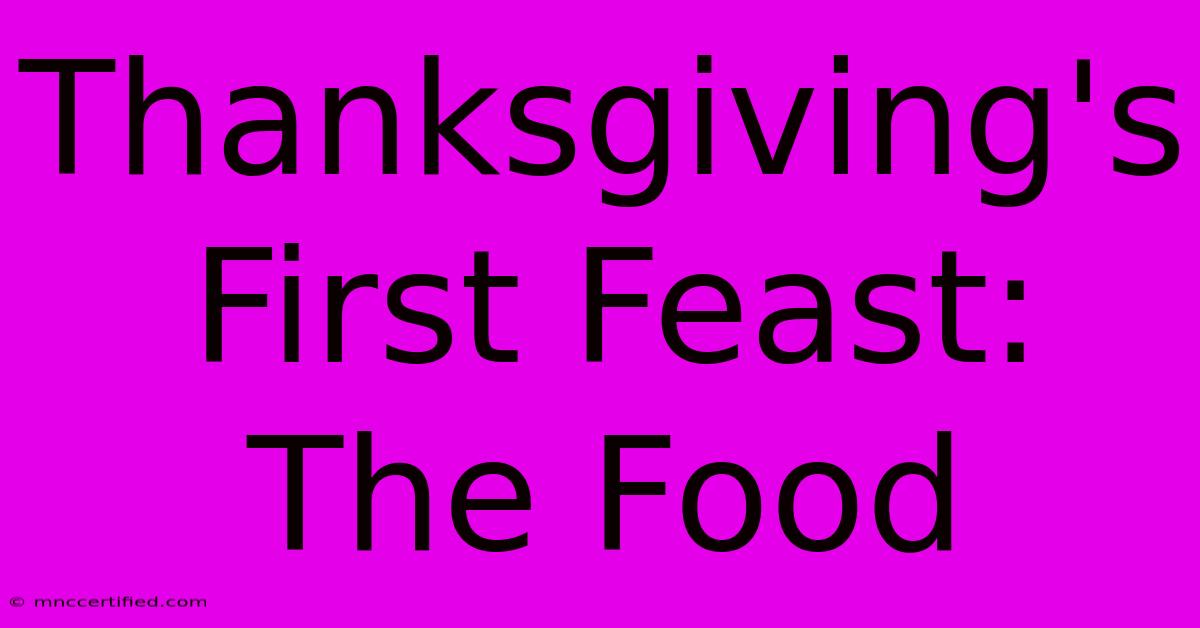Thanksgiving's First Feast: The Food

Table of Contents
Thanksgiving's First Feast: The Food – A Delicious Dive into History
Thanksgiving. The word conjures images of family, football, and, of course, a bountiful feast. But what did the first Thanksgiving meal actually consist of? While the romanticized image of the holiday often overshadows the reality, understanding the food of the first Thanksgiving offers a fascinating glimpse into 17th-century New England and the complex relationship between the Pilgrims and the Wampanoag.
Beyond the Myth: Separating Fact from Fiction
The popular image of the first Thanksgiving often relies on a heavily romanticized version of events. The truth is, detailed accounts of the harvest feast in 1621 are scarce. We primarily rely on two main sources: Edward Winslow's letter and William Bradford's history of Plymouth Plantation. These accounts paint a picture far removed from the modern Thanksgiving spread, lacking the ubiquitous turkey, stuffing, and pumpkin pie.
What Was on the Menu?
While we can't create a precise menu, based on historical records and archaeological evidence, we can make educated guesses about the food served at the 1621 harvest celebration:
-
Wildfowl: This is likely where the turkey myth stems from. While wild turkey was abundant, it’s probable that other wildfowl like ducks, geese, and swans were also served. These birds were easier to hunt in significant numbers than turkeys.
-
Venison: Deer were a crucial source of protein for the Pilgrims, and venison would have undoubtedly featured prominently in the feast.
-
Fish: The proximity to the ocean means various types of fish were readily available, likely including cod, bass, and shellfish.
-
Seafood: Along with fish, the abundance of shellfish would have been a crucial element in the meal. Clams, mussels, and oysters were likely part of the spread.
-
Wild Vegetables: The Pilgrims and Wampanoag would have gathered wild vegetables and berries native to the region, including cranberries (a Thanksgiving staple!), squash, beans, and possibly wild greens. These would have provided essential vitamins and flavor.
-
Corn: Corn was a staple crop for the Wampanoag, and it's highly likely that various corn dishes were served. This could have been in the form of succotash or simply boiled corn.
-
Nuts and Seeds: These provided additional calories and nutrients, adding to the overall variety of foods on offer.
The Wampanoag Contribution: A Crucial Element
It's crucial to remember the significant role the Wampanoag played in this harvest celebration. They brought their agricultural expertise and shared their knowledge of the land and its bounty. Their contribution was far more substantial than often acknowledged, and understanding their role is essential to grasping the true nature of the first Thanksgiving. Their addition of corn, beans, and squash to the table dramatically increased the nutritional value and variety of the meal.
A Simple Meal, a Rich History
The first Thanksgiving was a far cry from today's elaborate feasts. It was a simple gathering, reflecting the realities of survival in a new land. The food was a testament to both the resourcefulness of the Pilgrims and the generosity and knowledge of the Wampanoag. By understanding the true nature of that first meal, we can appreciate the historical significance of Thanksgiving and gain a deeper appreciation for the rich and complex history behind this American holiday.
Keywords for SEO:
- Thanksgiving's first feast
- First Thanksgiving food
- What did they eat at the first Thanksgiving?
- 1621 Thanksgiving menu
- Pilgrim food
- Wampanoag contribution to Thanksgiving
- Thanksgiving history
- Harvest feast
- Wildfowl
- Venison
- Seafood
- Corn
- Squash
- Cranberries
This article is optimized for various search terms related to the food of the first Thanksgiving, incorporating them naturally within the text. Remember to promote this article through social media and other online channels to boost its visibility and ranking.

Thank you for visiting our website wich cover about Thanksgiving's First Feast: The Food. We hope the information provided has been useful to you. Feel free to contact us if you have any questions or need further assistance. See you next time and dont miss to bookmark.
Featured Posts
-
Ogc Nice Vs Rangers Live Stream
Nov 29, 2024
-
Gregg Wallace Leaves Master Chef Amidst Allegations
Nov 29, 2024
-
Man Utd Vs Bodo Glimt Europa Live Stream
Nov 29, 2024
-
Gregg Wallace Master Chef Departure Amid Claims
Nov 29, 2024
-
Shaboozeys Thanksgiving Halftime Show
Nov 29, 2024